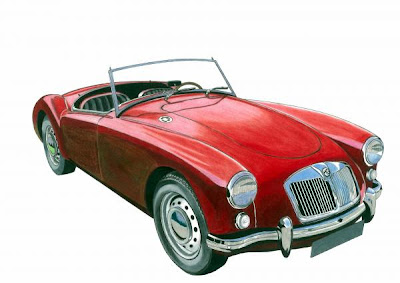MG TF 160
MG MGA
MG TF 160
MG MGA
The MGA is a sports car produced by MG division of the British Motor Corporation from 1955 to 1962.
The MGA replaced the older T-type cars and represented a complete styling break from the older vehicles. The car was officially launched at the Frankfurt Motor Show of 1955. It was replaced by the MGB when production ceased in July 1962. Through that time, BMC sold 101,081 units, the vast majority of which were exported with only 5869 cars sold on the home market, the highest export percentage of any British car.
The design dates back to 1952 when MG designer Syd Enever created a streamlined body for George Philips' TD Le Mans car. The problem with this car was the high seating position of the driver because of the limitations of using the TD chassis. A new chassis was designed with the side members further apart and the floor attached to the bottom rather than the top of the frame sections. A prototype was built and shown to the BMC chairman Leonard Lord. Lord turned down the idea of producing the new car as he had just signed a deal with Donald Healey to produce Austin-Healey Cars two weeks before. Falling sales of the traditional MG models caused a change of mind and the car, initially to be called the UA-series, was brought back. As it was so different from the older MG models it was called the MGA, the "first of a new line" to quote the contemporary advertising. There was also a new engine available so the car did not have the originally intended XPAG unit but was fitted with the BMC corporate B-Series type allowing a lower bonnet line.
It was a body-on-frame design and used the straight-4 "B series" engine from the MG Magnette saloon driving the rear wheels through a 4 speed gearbox. Suspension was independent with coil springs and wishbones at the front and a rigid axle with semi-elliptic springs at the rear. Steering was by rack and pinion and was not power assisted. The car was available with either wire spoked or steel disc road wheels.
MG MGA
Manufacturer MG Cars
Production : 1955-1962 (101,081 made)
Assembly : Abingdon, England
Predecessor : MG TF
Successor : MGB
Class : Sports Car
Body style(s) : 2-door roadster, 2-door coupe
Layout : FR layout
Wheelbase : 94 in (2388 mm)
Length : 156 in (3962 mm)
Width : 58 in (1473 mm)
Height : 50 in (1270 mm)
Curb weight : 1988 pounds (902 kg)
The MGA replaced the older T-type cars and represented a complete styling break from the older vehicles. The car was officially launched at the Frankfurt Motor Show of 1955. It was replaced by the MGB when production ceased in July 1962. Through that time, BMC sold 101,081 units, the vast majority of which were exported with only 5869 cars sold on the home market, the highest export percentage of any British car.
The design dates back to 1952 when MG designer Syd Enever created a streamlined body for George Philips' TD Le Mans car. The problem with this car was the high seating position of the driver because of the limitations of using the TD chassis. A new chassis was designed with the side members further apart and the floor attached to the bottom rather than the top of the frame sections. A prototype was built and shown to the BMC chairman Leonard Lord. Lord turned down the idea of producing the new car as he had just signed a deal with Donald Healey to produce Austin-Healey Cars two weeks before. Falling sales of the traditional MG models caused a change of mind and the car, initially to be called the UA-series, was brought back. As it was so different from the older MG models it was called the MGA, the "first of a new line" to quote the contemporary advertising. There was also a new engine available so the car did not have the originally intended XPAG unit but was fitted with the BMC corporate B-Series type allowing a lower bonnet line.
It was a body-on-frame design and used the straight-4 "B series" engine from the MG Magnette saloon driving the rear wheels through a 4 speed gearbox. Suspension was independent with coil springs and wishbones at the front and a rigid axle with semi-elliptic springs at the rear. Steering was by rack and pinion and was not power assisted. The car was available with either wire spoked or steel disc road wheels.
MG MGA
Manufacturer MG Cars
Production : 1955-1962 (101,081 made)
Assembly : Abingdon, England
Predecessor : MG TF
Successor : MGB
Class : Sports Car
Body style(s) : 2-door roadster, 2-door coupe
Layout : FR layout
Wheelbase : 94 in (2388 mm)
Length : 156 in (3962 mm)
Width : 58 in (1473 mm)
Height : 50 in (1270 mm)
Curb weight : 1988 pounds (902 kg)
Related : MG MGA From Wikipedia, the free encyclopedia, MG TF 160 Cars











 6:24 AM
6:24 AM
 Goohara
Goohara


















0 ความคิดเห็น:
Post a Comment